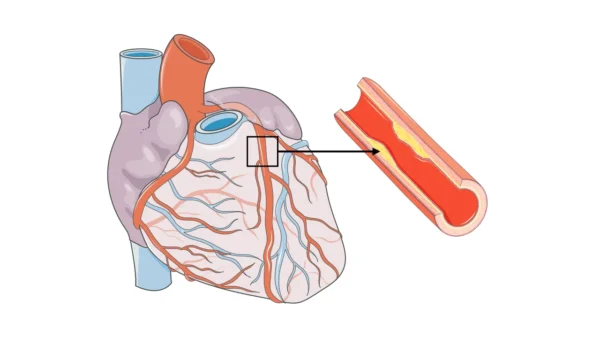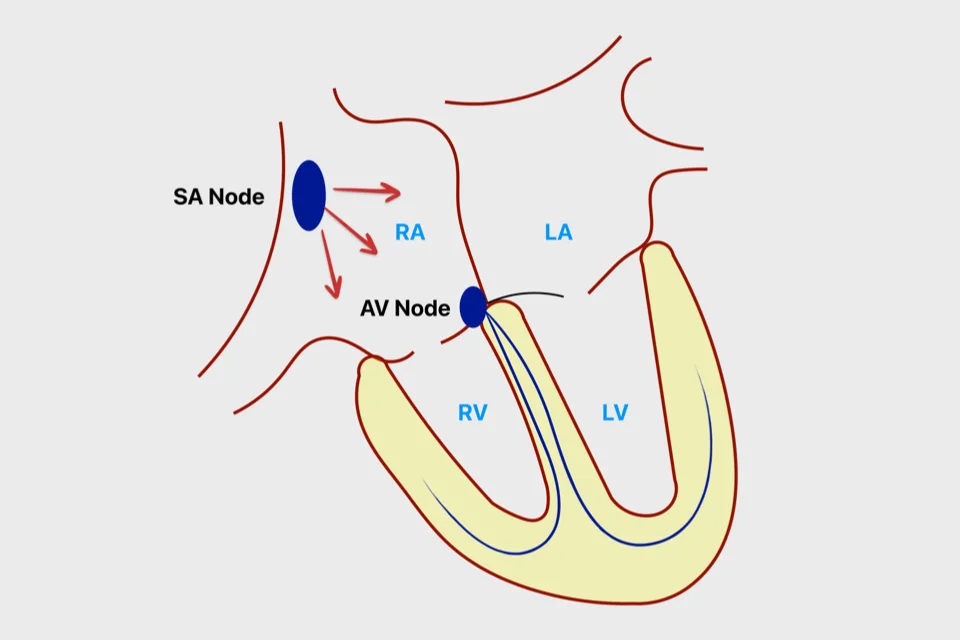Most people with heart problems have muscle that’s too weak or damaged. But some people have the opposite problem—their heart muscle grows abnormally thick. This is hypertrophic cardiomyopathy, a condition usually passed down through families. The thickened muscle makes it harder for your heart to relax and fill with blood between beats. In some people, the thick muscle also blocks blood flow trying to leave the heart. Many people with this condition live normal lives with no symptoms at all. Others experience shortness of breath, chest pain, or sudden rapid heartbeats. What concerns doctors most is that the abnormal muscle can trigger ventricular fibrillation—a chaotic rhythm where the heart quivers instead of pumping—which causes sudden death in young athletes if not immediately treated.
Overview
Hypertrophic cardiomyopathy is a condition where your heart muscle becomes abnormally thick, particularly the wall separating the two lower chambers. This thickening happens without any obvious reason like high blood pressure that would force the heart to work harder.
The thick muscle creates two problems. First, the stiff muscle can’t relax properly between beats, so your heart has trouble filling with blood. Less blood available means less pumped out with each beat. Second, in about one-third of people, the thickened muscle bulges into the chamber and blocks blood flow trying to leave the heart.
The condition is usually inherited. A genetic mutation causes heart muscle cells to grow abnormally. If one of your parents has the mutation, you have a 50% chance of inheriting it. However, not everyone with the mutation develops symptoms—this varies even within the same family.
Hypertrophic cardiomyopathy affects about 1 in 500 people. Many people live with it their entire lives without knowing. The condition can appear at any age but most commonly becomes apparent during teenage years or early twenties.
The most serious concern is sudden death in young people during intense exercise. The abnormal, disorganized muscle tissue can trigger ventricular tachycardia—where the lower chambers beat extremely fast—or ventricular fibrillation—where they quiver chaotically instead of pumping. When this happens, blood circulation stops and the person collapses. This is why hypertrophic cardiomyopathy is a leading cause of sudden cardiac death in young athletes, even though the overall risk for each person is relatively low.
Causes
Hypertrophic cardiomyopathy is primarily genetic, passed from parents to children.
- Specific gene mutations cause the problem. These genes provide instructions for making proteins that help heart muscle work. When mutations occur, the proteins don’t work correctly. Heart muscle cells grow larger than normal and arrange themselves in chaotic patterns rather than organized rows. This disorganized arrangement makes the muscle electrically unstable, which is why people with this condition can suddenly develop very fast, life-threatening heart rhythms.
- The inheritance pattern is straightforward. If one parent carries a mutation, each child has a 50% chance of inheriting it. Men and women are equally affected, though men often develop more severe symptoms.
- Having the genetic mutation doesn’t guarantee you’ll develop disease. Some people carry the mutation but never develop noticeable thickening or symptoms. Others develop severe disease. Even within the same family with identical mutations, severity varies dramatically.
- The thickening typically develops during teenage years when the body is growing rapidly. By late teens or early twenties, the thickening is usually complete, though it can continue slowly in some people.
Symptoms
Many people with hypertrophic cardiomyopathy have no symptoms at all. The condition is often discovered during routine checkups, family screening after someone is diagnosed, or during sports physicals.
- Shortness of breath is the most common complaint when symptoms do occur. You might notice it first during exercise but it can progress to happening with minimal activity. The stiff muscle can’t relax and fill properly, so less blood is pumped with each beat.
- Chest pain happens in many people, even without blocked arteries. The thickened muscle needs more oxygen than normal muscle, but blood supply hasn’t increased to match. This causes chest discomfort, particularly during exercise.
- Palpitations or feeling your heart suddenly racing are common. You might feel your heart beating extremely fast for periods of time. These episodes of rapid heartbeat can be ventricular tachycardia, where the lower chambers are beating 150-250 times per minute or faster. While frightening, these episodes sometimes stop on their own or with treatment.
- Dizziness or lightheadedness occurs, particularly during exercise. If the obstruction is severe or if rapid heart rhythms occur, blood flow to your brain drops, causing these symptoms.
- Fainting is more concerning. Passing out during or shortly after exercise indicates the heart rhythm became very fast or chaotic, cutting off blood flow to your brain. Any fainting episode needs immediate evaluation.
- Some people experience sudden cardiac arrest as their first sign. The heart suddenly develops ventricular fibrillation—chaotic quivering instead of pumping—and the person collapses during intense activity. Without immediate CPR and defibrillation, this is fatal. This is rare but tragic when it occurs.
Diagnosis
Diagnosing hypertrophic cardiomyopathy involves confirming heart muscle is abnormally thick.
- Physical examination often provides the first clue. Your doctor may hear specific abnormal sounds through a stethoscope—murmurs created by turbulent blood flow.
- Electrocardiogram shows abnormal electrical patterns in most people with this condition, though some have completely normal tests.
- Echocardiography is the main diagnostic test. This ultrasound creates moving images of your heart, clearly showing thickened walls, how well the heart pumps, and whether obstruction is present. The test measures exactly where thickening occurs and how severe it is.
- Extended heart monitoring with wearable devices captures episodes of rapid heartbeat that come and go. This is important because brief episodes of ventricular tachycardia might occur without you noticing, but they indicate increased risk.
- Genetic testing identifies specific mutations in about 60% of people. Finding a mutation confirms the diagnosis and allows testing of family members.
Treatment
Treatment aims to relieve symptoms and reduce the risk of sudden death from ventricular tachycardia or ventricular fibrillation. The approach varies depending on symptoms and severity.
- For people without symptoms, regular monitoring is often all that’s needed. Checkups every year or two track whether the condition is changing. Many people live their entire lives needing only observation.
- Medications help when symptoms develop. Beta-blockers slow heart rate and help the heart relax better. They also make the heart less likely to develop rapid, dangerous rhythms. Other medications work similarly, helping the muscle relax or reducing obstruction.
- For severe obstruction causing significant symptoms despite medications, surgery can remove a portion of the thickened muscle. This dramatically improves symptoms. A less invasive option uses alcohol injected through a tube to destroy a small amount of thickened muscle, reducing obstruction.
- Implantable defibrillators prevent sudden death in high-risk individuals. These devices continuously monitor heart rhythm. If ventricular tachycardia or ventricular fibrillation occurs, the device automatically delivers shocks within seconds to restore normal rhythm, preventing death. They’re recommended for people who’ve survived cardiac arrest, have unexplained fainting, very thick muscle, or family history of sudden death from this condition. The device doesn’t prevent these fast rhythms from starting, but it ensures they don’t become fatal.
Activity and Sports
Intense competitive sports are strongly discouraged. The combination of very high heart rates, adrenaline surges, and physical stress during competitive athletics creates the perfect conditions for triggering ventricular tachycardia or ventricular fibrillation. This is why young athletes with undiagnosed hypertrophic cardiomyopathy sometimes collapse and die suddenly during games or competitions.
This doesn’t mean you can’t exercise at all. Regular moderate physical activity is encouraged. Walking, light jogging, golf, and similar activities typically pose minimal risk. Your cardiologist helps determine appropriate activity levels based on your specific situation.
For diagnosed athletes, giving up competitive sports is emotionally difficult. Support from family and counselors helps with this transition.
Family Screening
- Because hypertrophic cardiomyopathy is inherited, family screening is crucial when someone is diagnosed.
- Parents, siblings, and children should undergo evaluation including physical examination, electrocardiogram, and echocardiography.
- Children are typically first screened around age 10-12, with repeat screening every 1-2 years through teenage years since thickening often develops during this time.
- Genetic testing changes the screening approach. Family members who test negative for the known mutation don’t need ongoing monitoring. Those who test positive need regular screening even if their hearts look normal.
Key Points
- Hypertrophic cardiomyopathy is a genetic condition where heart muscle becomes abnormally thick. This makes it harder for the heart to relax and fill with blood, and sometimes blocks blood flow.
- Each child of an affected parent has a 50% chance of inheriting the mutation. Severity varies dramatically, even within families.
- Many people have no symptoms and live normal lives. Others develop shortness of breath, chest pain, or episodes of very rapid heartbeat. The most serious risk is ventricular fibrillation—where the heart quivers chaotically instead of pumping—which causes sudden death during intense exercise if not immediately treated.
- Treatment includes medications to improve symptoms and reduce the risk of dangerous fast rhythms, surgery when needed, and implantable defibrillators to prevent sudden death in high-risk individuals. These devices automatically shock the heart back to normal rhythm if ventricular tachycardia or ventricular fibrillation occurs.
- Intense competitive sports are strongly discouraged because they can trigger these life-threatening rhythms. Moderate exercise is usually acceptable.
- All close relatives should be screened. The condition runs in families, so finding it early in family members allows proper management before serious problems develop.
- Most people live normal lifespans with appropriate management, though some need medications or activity modifications. The key is proper diagnosis, appropriate treatment including defibrillators when indicated, family screening, and regular follow-up.
You may also like to read these:
Reference: Hypertrophic cardiomyopathy






